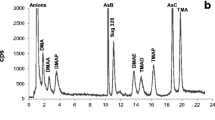Abstract
Ion chromatography-ultra violet-hydride generation-Atomic Florescence Spectrometry was applied to detect 5 arsenic species in seafoods. The arsenic species studied include arsenobetaine (AsB), arsenite (As(III)), dimethylarsinic acid (DMA), monomethylarsonic acid (MMA), and arsenate (As(V)), which were extracted from samples using 2% formic acid. Gradient elution using 33 mmol L−1 CH3COONH4 and 15 mmol L−1 Na2CO3 with 10 mL CH3CH2OH at pH 8.4 allowed the chromatographic separation of all the species on a Hamilton PRP-X100 anion-exchange column in less than 8 min. In this study, an ultrasound extraction method was used to extract arsenic species from seafood. The extraction efficiency was good and the recoveries from spiked samples were in the range of 72.6%–109%; the precision between sample replicates was higher than 3.6% for all determinations. The detection limits were 3.543 μg L−1 for AsB, 0.426 μg L−1 for As(III), 0.216 μg L−1 for DMA, 0.211 μg L−1 for MMA, and 0.709 μg L−1 for As(V), and the linear coefficients were greater than 0.999. We also developed an application of this method for the determination of arsenic species in bonito, Euphausia superba, and Enteromorpha with satisfactory results. Therefore, it was confirmed that this method was appropriate for the detection of arsenic species in seafood.
Similar content being viewed by others

References
Aznar, M., Canellas, E., and Nerín, C., 2009. Quantitative determination of 22 primary aromatic amines by cation-exchange solid-phase extraction and liquid chromatographymass spectrometry. Journal of Chromatography A, 1216 (27): 5176–5181.
Chakraborty, S., Alam, M. O., Bhattacharya, T., and Singh, Y. N., 2014. Arsenic accumulation in food crops: A potential threat in bengal delta plain. Water Quality Exposure & Health, 6: 1–14.
Chang, W. Y., Sung, Y. H., and Huang, S. D., 2003. Analysis of carcinogenic aromatic amines in water samples by solidphase microextraction coupled with high-performance liquid chromatography. Analytica Chimica Acta, 495 (1): 109–122.
Daus, B., Wennrich, R., Morgenstern, P., Wei, H., Nalini, H. A., and Leonel, L. V., 2005. Arsenic speciation in plant samples from the iron quadrangle, minas gerais, brazil. Microchimica Acta, 151 (3–4): 175–180.
Deng, F., Dong, R., Yu, K., Luo, X., Tu, X., and Luo, S., 2013. Determination of trace total inorganic arsenic by hydride generation atomic fluorescence spectrometry after solid phase extraction-preconcentration on aluminium hydroxide gel. Microchimica Acta, 180 (5–6): 509–515.
Fendorf, S., Michael, H. A., and Geen, A. V., 2010. Spatial and temporal variations of groundwater arsenic in south and southeast Asia. Science, 328 (5982): 1123–1127.
Francesconi, K., Visoottiviseth, P., Sridokchan, W., and Goessler, W., 2002. Arsenic species in an hyperaccumulating fern, pityrogramma calomelanos: A potential phytoremediator. Science of the Total Environment, 284: 27–35. GB/T 23372-2009 Determination of inorganic-arsenic in foods-Liquid chromatography-inductive coupled plasma mass spectrometer, China.
Guo, H., Zhong, Z., Mei, L., Xue, X., Wan, X., and Zhao, J., 2012. Arsenic uptake from arsenic-contaminated water using hyperaccumulator pteris vittata l.: Effect of chloride, bicarbonate, and arsenic species. Water Air & Soil Pollution, 223 (7): 4209–4220.
Heitkemper, D. T., Vela, N. P., Stewart, K. R., and Westphal, C. S., 2001. Determination of total and speciated arsenic in rice by ion chromatography and inductively coupled mass spectrometry. Journal of Analytical Atomic Spectrometry, 16: 299–306.
Hong, S. H., Choi, S. A., Lee, M. H., Min, B. R., Yoon, C., and Yoon, H., 2011. Effect of arsenic species on the growth and arsenic accumulation in cucumis sativus. Environmental Geochemistry & Health, 33 (1): 41–47.
Hu, Z., Gao, S., Gü nther, D., Hu, S., Liu, X., and Yuan, H., 2006. Direct determination of tellurium in geological samples by inductively coupled plasma mass spectrometry using ethanol as a matrix modifier. Applied Spectroscopy, 60 (7): 781–785.
Jedynak, L., Kowalska, J., Kossykowska, M., and Golimowski, J., 2010. Studies on the uptake of different arsenic forms and the influence of sample pretreatment on arsenic speciation in white mustard (Sinapis alba). Microchemical Journal, 94 (2): 125–129.
Niazi, N. K., Singh, B., Zwieten, L. V., and Kachenko, A. G., 2012. Phytoremediation of an arsenic-contaminated site using pteris vittata l. and Pityrogramma calomelanos var. austroamericana: A long-term study. Environmental Science & Pollution Research, 19 (8): 3506–3515.
Noguchi, Y., Fukuda, K., Matsushima, A., Haishi, D., Hiroto, M., and Kodera, Y., 1999. Inhibition of df-protease associated with allergic diseases by polyphenol. Journal of Agricultural & Food Chemistry, 47 (8): 2969–2972.
Rezende, H. C., and Coelho, N. M., 2014. Determination of total arsenic and arsenic (iii) in phosphate fertilizers by hydride generation atomic absorption spectrometry after ultrasound-assisted extraction based on a control acid media. Journal of Aoac International, 97 (3): 736–741.
Yang, S. J., Tang, B. P., Wang, D. C., Rao, W., Zhang, Y. N., and Wang, D., 2014. Influence of sulfur on the bioavailability of arsenic uptake by rice (oryza. sativa l.) and its speciation in soil. Environmental Science, 35 (9): 3553–3563.
Yusuf, B., Gabriella, L., Hugo, P., Florence, P., Annette, A., and Martine, P. G., 2002. Speciation of arsenic in plants by HPLC-HG-AFS: Extraction optimisation on crm materials and application to cultivated samples. Journal of Environmental Monitoring Jem, 4 (4): 596–602.
Zdenka, S., Emese, K., Ildi, I., and Elteren, J. T. V., 2006. Arsenosugars and other arsenic compounds in littoral zone algae from the adriatic sea. Chemosphere, 63 (7): 1098–1105.
Acknowledgements
This work was funded by the National Major Scientific Instrument and Equipment Development Project of China (No.2012YQ090229). We would like to express our thanks to the two anonymous reviewers for critical reviews and comments on the manuscript.
Author information
Authors and Affiliations
Corresponding author
Rights and permissions
About this article
Cite this article
Han, T., Ji, H., Li, H. et al. Speciation analysis of arsenic compounds in seafood by ion chromatography-atomic fluorescence spectrometry. J. Ocean Univ. China 16, 455–460 (2017). https://doi.org/10.1007/s11802-017-3070-9
Received:
Revised:
Accepted:
Published:
Issue Date:
DOI: https://doi.org/10.1007/s11802-017-3070-9



